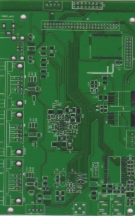Generally, high-density PCB soft boards are defined by their ability to handle fine lines and micro-holes. The line pitch (Pitch) is less than 150μm, and the micro-hole diameter is also below 150μm, according to IPC standards. The density of these PCB soft boards continues to decrease. The applications of high-density PCB soft boards can be categorized into several fields:
1. IC carrier boards: such as CSP and BGA.
2. Information products: including hard disks and inkjet printers.
3. Consumer products: like cameras and mobile phones.
4. Office automation products: such as facsimile machines.
5. Medical products: including hearing aids and defibrillators.
6. LCD modules.
It is evident that the demand for high-density PCB soft boards over the past two years has significantly surpassed that of traditional FPC. This article will explore several high-density PCB soft boards that are currently in high demand.
**Application**
1. **TBGA (Tape Ball Grid Array)**
IC packaging has increasingly shifted towards lightweight solutions. Many companies are opting to use flexible boards as IC substrates. In addition to their high density, superior heat dissipation and electrical properties are also key reasons for their selection.

1. TBGA employs a flexible board as the IC carrier, achieving fine line and thin effects. Currently, single-layer copper is predominant, though the adoption of double-layer metal is on the rise. TBGA mass production sizes range from 11mm x 11mm to 42.5mm x 42.5mm, with pin counts varying from 100 to 768. Figure 6 illustrates SONY’s TBGA utilizing a flexible board as its substrate. Larger TBGA packages typically feature 256 and 352 pins in 35mm x 35mm configurations. TBGA applications include microprocessors, chipsets, memory, DSP, ASIC, and PC network systems.
2. The Chip Scale Package (CSP) focuses on minimizing the package volume relative to chip size. There are four primary types: Rigid Substrate, Lead Frame, Flex Interposer, and Wafer Level, with the latter using a high-density PCB flexible board as the IC carrier. A key distinction from TBGA is that CSP uses a fan-in assembly method, resulting in a final size not exceeding 1.2 times that of the IC, thus categorizing it as chip-level assembly. Typical assembly ICs include Flash memory, SILM, ASIC, and DSPs, which are found in digital cameras, camcorders, mobile phones, and memory cards. Traditionally, Wire Bonding connects the IC to the flexible carrier, but the Flip Chip method is increasingly employed. The main connection method to the PCB is through a solder ball array (BGA). CSP package sizes range from 6mm x 6mm to 17mm x 17mm, with pitch distances from 0.5mm to 1.0mm. TI’s μStar BGA offers a representative view of the soft-board CSP structure. Tessera’s μBGA is a pioneering CSP model, with several domestic companies authorized to produce it.
3. Historically, LCD driver ICs were predominantly assembled via TAB (Tape Automatic Bonding) using high-density PCB soft boards. External pins connected to the LCD through anisotropic conductive adhesive (ACF), linking to the panel’s ITO electrode, achieving a minimum pitch of 50μm. The TAB tape measures 48mm and 7mm wide, with a typical count of 380. Main applications include mobile phones, camcorders, and notebooks. However, TAB assembly only integrates the driver IC, necessitating another PCB for passive components, hindering overall size reduction. Consequently, the COF (Chip on Flex) method emerged as an alternative high-density PCB assembly solution, allowing passive components like resistors and capacitors to be mounted on the same substrate, addressing structural complexity and size challenges. This method is gaining popularity in LCD assembly, but it faces hurdles such as material adhesion and thickness, which impact manufacturing (line width of 150μm), equipment development (below 50μm transmission), and material supply (adhesive-free copper).
4. The inkjet head assembly in inkjet printers also utilizes high-density soft boards. Currently, a non-adhesive soft board with a resolution around 150μm is common, with a typical size of 24mm. This high-density PCB soft board market is primarily dominated by 3M.
5. With rapid advancements in information technology, the Internet, and digital imaging, data storage solutions like hard disk drives (HDD) have seen significant growth in both capacity and speed. This includes HDDs for PCs, notebooks, and high-capacity memory devices for digital cameras and recorders, all requiring R/WFPC soft boards for their read-write heads. This highlights stringent design needs for high-density structures and reliability under conditions that may reach 80°C while enduring high-speed vibrations.
3. Development Trends and Technical Requirements
1. Fine Lines & Microvia: For instance, COF’s pitch is expected to reduce to 25μm–50μm, posing challenges for substrate adhesion, thickness, and wiring processes, necessitating innovations in drilling methods like lasers for blind and buried holes.
2. Microvias: With hole sizes down to 50μm, traditional drills fall short; laser drilling is necessary to etch PI film, commonly used in IC substrates like CSP and TAB.
3. Flying Leads: Specialized high-density PCB soft boards can be etched to create flying leads, allowing for direct hot-pressing or welding to rigid boards.
4. Small Coverlay Openings: As coverlay openings shrink to 50μm or less, traditional punching techniques become inadequate, leading to the development of PIC (Photoimageable Coverlayer) to meet future demands.
5. Surface Finish: Lead-free processes, including nickel-gold and electroplated finishes, are projected to become the mainstream.
6. Microbump Array: With CSP and Flip Chip’s reliability requirements, microbump arrays will challenge soft board production.
7. Dimensional Control: Miniaturization demands increased precision across material selection, layout design, equipment, and process control.
8. Inspection: Future high-density PCB soft board pre-shipment inspections may rely on AOI and non-contact electrical tests.
Concluding Remarks
To sustain high growth and profitability, flexible substrates must evolve towards large-scale applications, necessitating advancements in materials, particularly non-adhesive bases and photosensitive protective films, which are vital for high-density PCB soft boards.




